If you’re starting your investing journey, I recommend checking out beginner-friendly books like *The Little Book of Common Sense Investing*, *Investing 101*, and *A Beginner’s Guide to the Stock Market*. These guides simplify complex concepts and offer practical strategies to build confidence. Many focus on low-cost investing, dividend income, and understanding markets. Keep in mind, choosing the right book depends on your goals and experience—it’s worth exploring what’s best for you to gain a solid foundation.
Key Takeaways
- Focus on beginner-friendly books that simplify complex investing concepts and provide practical step-by-step guidance.
- Prioritize resources covering stocks, ETFs, and long-term growth strategies suitable for new investors.
- Look for titles that include real-world examples, stories, and actionable advice to build confidence.
- Select books tailored to American markets but offering broad foundational knowledge for global applicability.
- Consider resources that address common beginner challenges like account setup, risk management, and investment mindset.
The Little Book of Common Sense Investing

Are you new to investing and feeling overwhelmed by all the options and strategies out there? “The Little Book of Common Sense Investing” by John Bogle is a great starting point. It champions simple, low-cost index funds that track the overall market, like the S&P 500. Bogle stresses that trying to beat the market through active trading usually backfires because of high costs, taxes, and emotional decisions. Instead, he recommends a buy-and-hold approach, minimizing expenses, and trusting the market’s long-term growth. This straightforward strategy has helped countless investors build wealth without the stress of constantly monitoring or trying to outsmart the market.
Best For: new investors seeking a simple, low-cost, long-term strategy to build wealth without the stress of active management.
Pros:
- Emphasizes low-cost index funds, reducing expenses and maximizing net returns
- Promotes a buy-and-hold approach, minimizing trading and emotional decisions
- Supported by extensive historical data showing long-term outperformance of passive investing
Cons:
- Less suitable for investors interested in aggressive, active trading or sector bets
- May underperform in certain emerging markets where active management could offer advantages
- Requires patience and discipline, which might be challenging for short-term focused investors
Turning Rental Properties into Passive Income Profit

If you’re new to real estate investing and looking for a practical, step-by-step guide to generate passive income through rental properties, this book is an excellent choice. It provides clear insights into market opportunities driven by population growth and urbanization, while also highlighting risks like economic downturns and interest rate fluctuations. The book breaks down the essentials of property management, covering location choices, tenant screening, and maintenance. With straightforward advice, real-life examples, and tools to evaluate deals, it empowers beginners to take manageable steps toward building wealth. Most importantly, it shows that with strategy and persistence, turning rental properties into passive income is an achievable goal.
Best For: Beginners and aspiring real estate investors seeking a practical, step-by-step guide to building passive income through rental properties.
Pros:
- Provides clear, actionable advice with real-life examples and tools for deal evaluation.
- Simplifies complex investing concepts into 10 manageable steps, making it accessible for newcomers.
- Emphasizes motivation and confidence-building to inspire investors to start and grow their portfolios.
Cons:
- May require additional research for specific local market trends and legal considerations.
- Focuses primarily on beginner strategies, possibly lacking advanced investment techniques.
- Some readers might find the step-by-step approach too basic if they already have some experience.
The Only Real Estate & Rental Property Investing Book for Beginners

This book stands out as the ultimate starting point for anyone new to real estate investing, especially those feeling overwhelmed by complex concepts or unsure where to begin. “The Only Real Estate & Rental Property Investing For Beginners Book You’ll Ever Need” offers clear, step-by-step strategies that make it easy to close your first deal, manage properties confidently, and generate passive income. It covers diverse investment types, emphasizes cash flow, and provides practical tools like checklists, scripts, and calculators. The authors, Andrew and Courtney James, focus on real-world tactics that cut through overwhelm, helping beginners build wealth efficiently and confidently from the start.
Best For: beginners and aspiring real estate investors seeking straightforward, actionable guidance to start building passive income through rental properties.
Pros:
- Provides step-by-step strategies and practical tools like checklists, scripts, and calculators for easier implementation
- Focuses on cash flow and real-world tactics, making complex concepts accessible and actionable
- Includes bonuses covering deal structuring, creative financing, and management shortcuts to accelerate success
Cons:
- May oversimplify some advanced investment strategies for more experienced investors
- The emphasis on beginner-friendly approaches might limit depth for those seeking detailed technical analysis
- The focus on quick results could encourage rushing deals without thorough due diligence in some cases
Investing 101: Building a Profitable Portfolio Primer
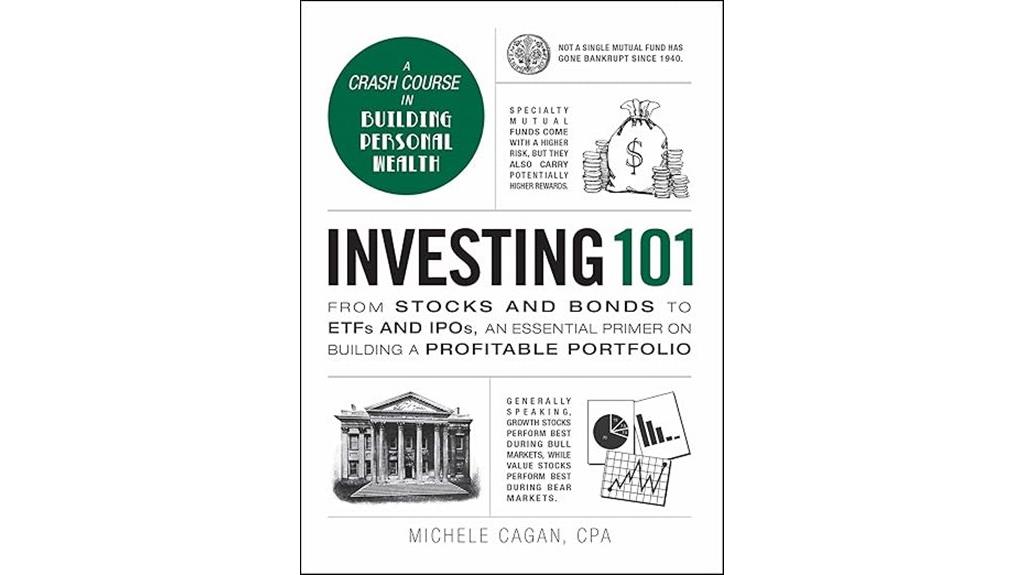
Investing 101: Building a Profitable Portfolio Primer stands out as an ideal starting point for beginners who want a clear, jargon-free introduction to the world of investing. I appreciate how it simplifies complex concepts like stocks, bonds, ETFs, and IPOs, making them accessible without overwhelming jargon. The book’s practical approach and engaging tidbits helped me understand key principles, including risk tolerance and value investing. It’s well-organized and manageable, perfect for self-study or gifting. After reading, I felt more confident articulating my financial goals and making informed decisions. This primer truly demystifies investing, serving as a solid foundation for building a profitable portfolio.
Best For: Beginners seeking a clear, accessible introduction to investing concepts and practical strategies for building a profitable portfolio.
Pros:
- Simplifies complex investment topics without using excessive jargon
- Well-organized and manageable for self-study or gifting
- Boosts confidence in articulating financial goals and making informed decisions
Cons:
- May lack in-depth analysis for advanced investors
- Focuses primarily on foundational concepts, less on complex strategies
- Some readers might desire more detailed case studies or real-world examples
A Beginners Guide to the Stock Market
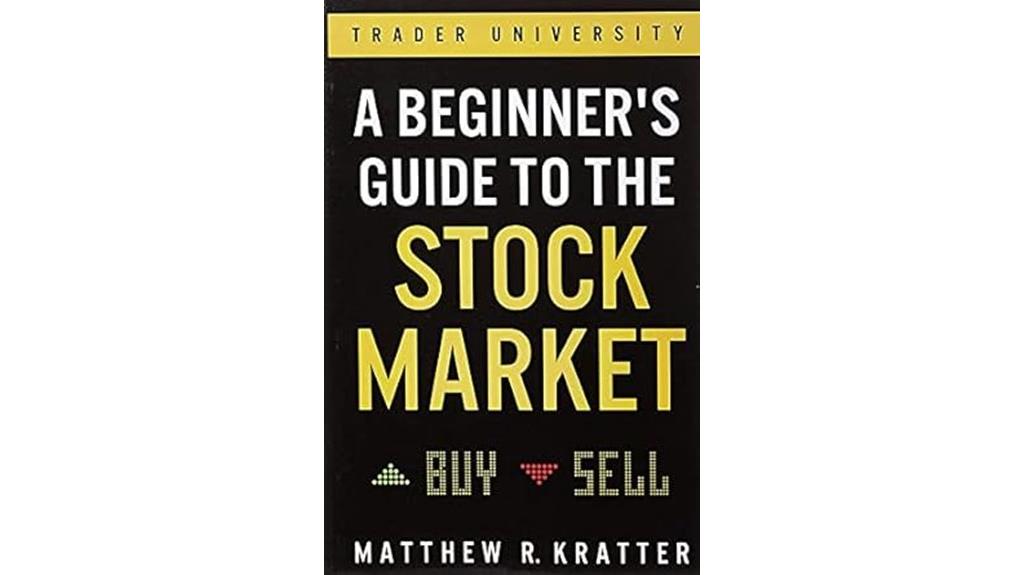
For anyone new to investing, “A Beginners Guide to the Stock Market” by Matthew Kratter offers a straightforward and practical introduction. As a retired hedge fund manager with over 20 years of experience, Kratter simplifies complex ideas, making them accessible for beginners. The book covers essential topics like opening accounts, buying stocks, spotting explosive opportunities, and avoiding common pitfalls. It emphasizes practical strategies and insider tips used by professionals, helping readers build confidence and start making money efficiently. I found it motivating and easy to understand, making it a perfect starting point for anyone enthusiastic to learn how the stock market works and grow their wealth responsibly.
Best For: Beginners eager to learn the fundamentals of stock market investing with clear, practical guidance from an experienced professional.
Pros:
- Simplifies complex investment concepts, making them accessible for newcomers
- Offers practical strategies and insider tips used by professionals
- Motivates readers to start investing responsibly with confidence
Cons:
- Focuses mainly on beginner-level content, may lack advanced investment strategies
- Might require supplementary research and practice accounts for hands-on experience
- Some readers may find the concise coverage less detailed than more comprehensive guides
Investing All-in-One For Dummies
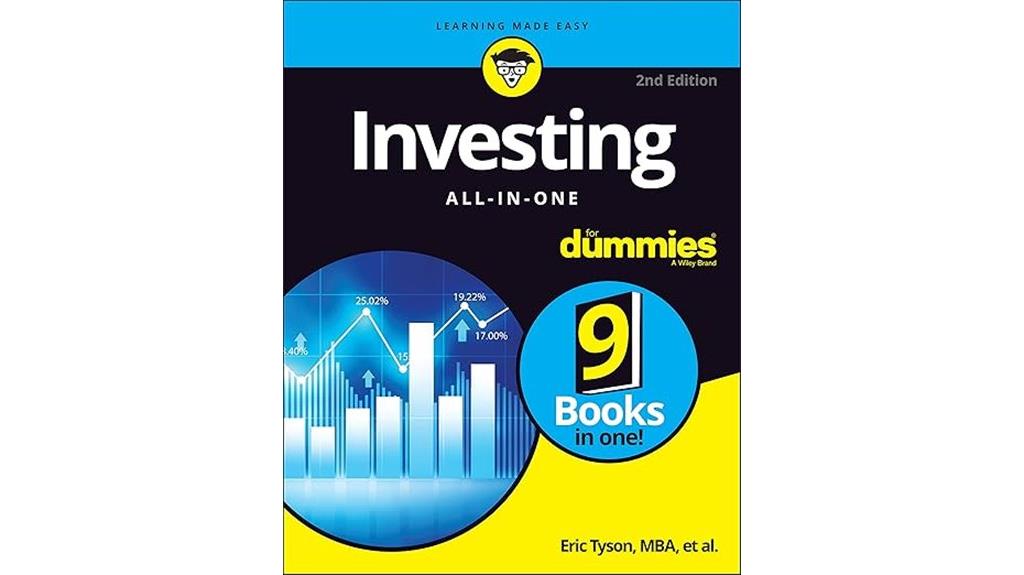
Are you looking for a straightforward, all-in-one guide that breaks down complex investing concepts without talking down to you? Investing All-in-One For Dummies is perfect for beginners wanting a clear, thorough overview. It covers everything from stocks and real estate to cryptocurrency, offering practical advice on setting goals, choosing investments, and managing risk. I found it easy to read and packed with useful details, making it a handy reference for both new and experienced investors. While primarily tailored to American markets, its broad coverage helps build a solid foundation. This book is a valuable tool for anyone keen to understand investing and build a diversified portfolio.
Best For: beginners and intermediate investors seeking a comprehensive, easy-to-understand guide to investing across various asset classes.
Pros:
- Clearly explains complex investing concepts in accessible language
- Offers practical, actionable advice for setting goals and choosing investments
- Serves as a thorough reference for both new and experienced investors
Cons:
- Primarily tailored to American markets, limiting relevance for international readers
- Contains some technical jargon that may challenge complete beginners
- Its dense content requires dedicated time and note-taking for full comprehension
Stock Investing For Beginners
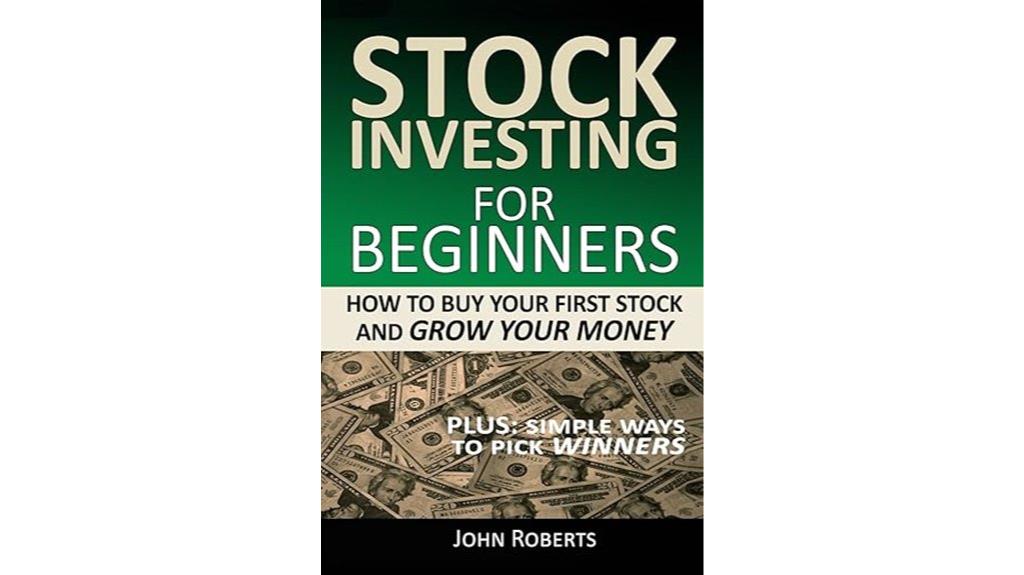
If you’re new to the world of stocks and feeling overwhelmed by all the jargon, this book is an excellent starting point. It breaks down essential concepts like what stocks are, why investing matters, and how the stock market works, using simple analogies like comparing an exchange to an auction. I found it inspiring to learn that even an ordinary janitor built an $8 million fortune through investing. The book focuses on building confidence and understanding basic mechanics, guiding you step-by-step on opening an account, buying, and selling stocks. It’s a straightforward, accessible way to start your investment journey with small, manageable actions.
Best For: Beginners who are feeling overwhelmed by stock market jargon and want a simple, accessible guide to start investing confidently.
Pros:
- Provides clear, straightforward explanations of stock market basics using simple analogies.
- Focuses on building confidence and motivating new investors with inspiring stories.
- Offers practical, step-by-step guidance on opening accounts and making initial trades.
Cons:
- Does not cover advanced analysis, trend reading, or technical research techniques.
- May lack in-depth strategies for more experienced or intermediate investors.
- Focuses primarily on the basics, which might require supplementary resources for comprehensive understanding.
Buffett’s 2-Step Stock Market Strategy
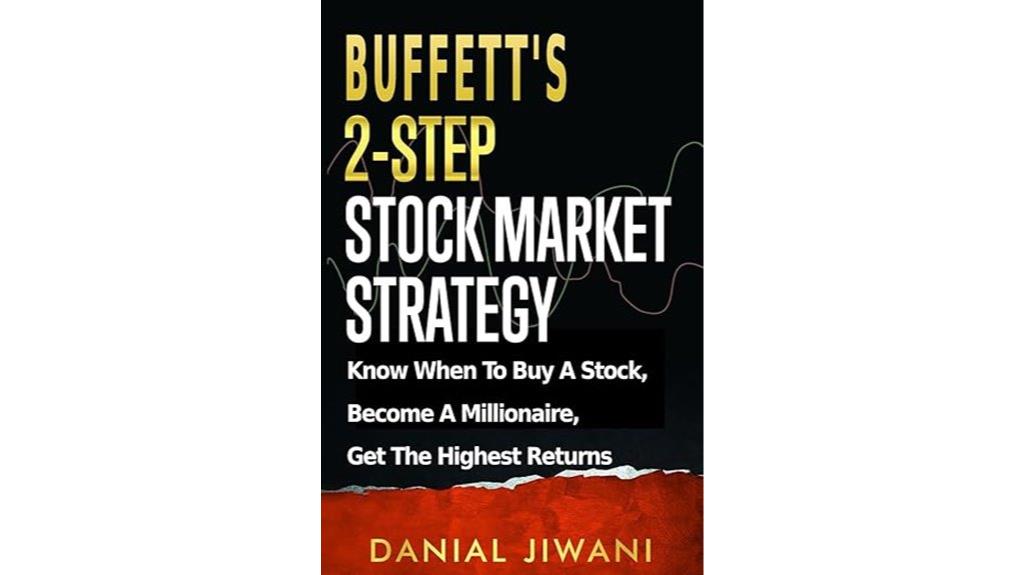
Anyone new to investing looking for a straightforward, practical approach will find Buffett’s 2-Step Stock Market Strategy particularly useful. It simplifies Warren Buffett’s proven method into two clear steps: focus on quality companies that generate consistent cash flow, and buy when their intrinsic value is undervalued, ensuring a margin of safety. The strategy emphasizes understanding a company’s ability to produce cash, not just relying on traditional metrics. It encourages patience, disciplined decision-making, and long-term growth. By applying these principles, many investors have achieved impressive gains, like over 500% in Apple. This approach makes value investing accessible and effective for beginners willing to learn and stay disciplined.
Best For: beginner and long-term investors seeking a clear, practical, and disciplined approach to value investing inspired by Warren Buffett’s principles.
Pros:
- Simplifies Buffett’s investment philosophy into two actionable steps.
- Focuses on understanding a company’s cash flow and intrinsic value rather than relying solely on traditional metrics.
- Emphasizes patience, discipline, and long-term growth, making it suitable for new investors.
Cons:
- Some readers find the detailed math and formulas for intrinsic value calculation complex or slow down understanding.
- Lacks in-depth tools or guidance for advanced investors needing precise valuation techniques.
- Does not introduce entirely new concepts but reinforces well-known value investing principles, which may seem repetitive to experienced investors.
Teenager’s Guide to Investing in Stocks: Invest Now, Play Later
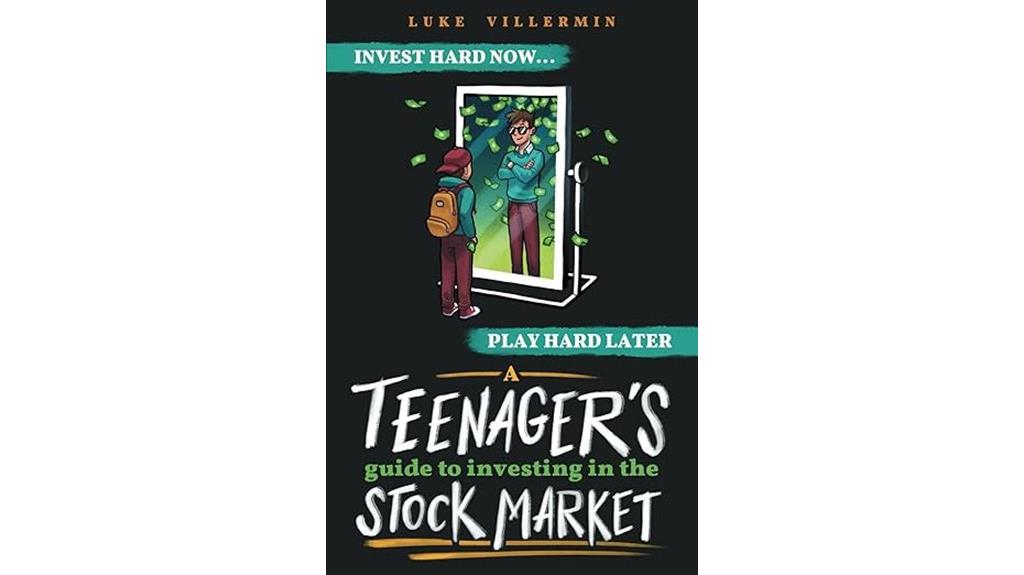
Teenagers enthusiastic to build a solid financial future will find “Teenager’s Guide to Investing in Stocks” an essential resource. Starting early makes a huge difference—just $125 a month from a young age can turn into a millionaire. Waiting until your thirties can cost you over 2.5 million dollars in retirement savings. This guide shows you how to open accounts, buy stocks, and understand market basics. It’s designed to boost your confidence, demystify Wall Street, and empower you to take control of your money. Remember, investing now means playing later—so the earlier you start, the brighter your financial future.
Best For: Teenagers and young adults eager to learn about investing early and build a strong financial foundation for the future.
Pros:
- Simplifies complex investing concepts to make them accessible for beginners
- Provides practical, step-by-step guidance on opening accounts and purchasing stocks
- Encourages proactive financial habits that can lead to significant long-term wealth
Cons:
- May not cover advanced investment strategies suitable for experienced investors
- Focused primarily on stock market investing, possibly overlooking other asset classes
- Requires a proactive attitude and discipline from teenagers to follow through on advice
LLC Beginners Guide (All-in-1)
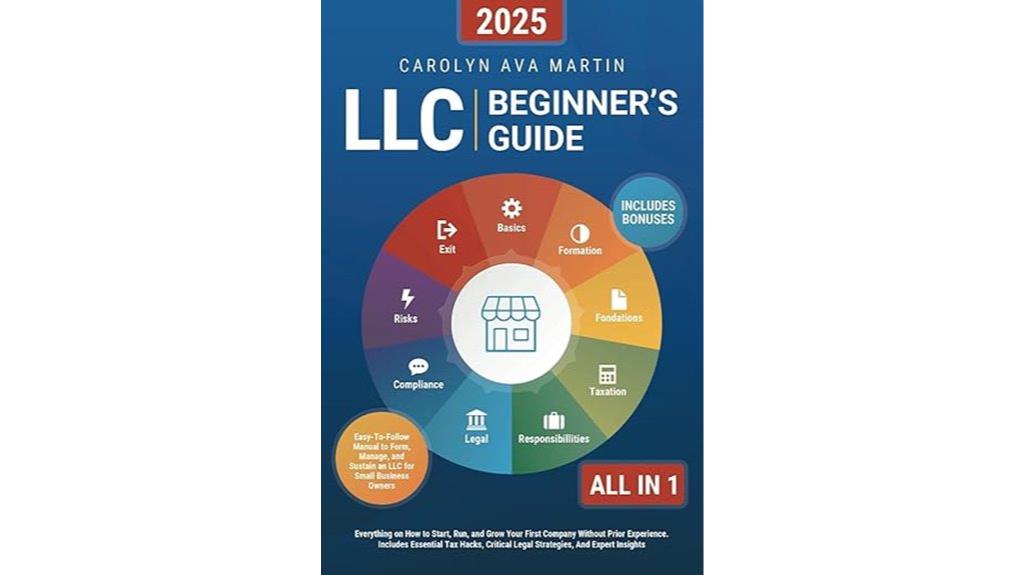
Looking to start an LLC but feeling overwhelmed by legal jargon and complex procedures? I’ve been there, and that’s why I recommend the LLC Beginners Guide (All-in-1). It breaks down core principles, types, and structures step-by-step, making the formation process straightforward. It simplifies legal requirements, so you can stay compliant without stress, and offers practical tips to manage risks. The guide also covers operational strategies for growth, financial planning, and exit options, helping you build a sustainable, protected business. With real-world examples and actionable advice, this resource ensures you’re equipped to launch and grow your LLC confidently.
Best For: Entrepreneurs and small business owners seeking a clear, step-by-step guide to forming and managing an LLC without legal jargon or complexity.
Pros:
- Simplifies complex legal and procedural information for easy understanding
- Provides practical tips on risk management, operational growth, and financial planning
- Includes real-world examples and actionable advice to build confidence in launching and expanding an LLC
Cons:
- May not cover highly specialized legal or industry-specific requirements
- Lacks personalized legal or financial consultation tailored to individual circumstances
- Focuses primarily on foundational knowledge, which might require additional resources for advanced strategies
Creating Your Income Snowball: The Passive Investing Cheat Code for Mastering Wealth
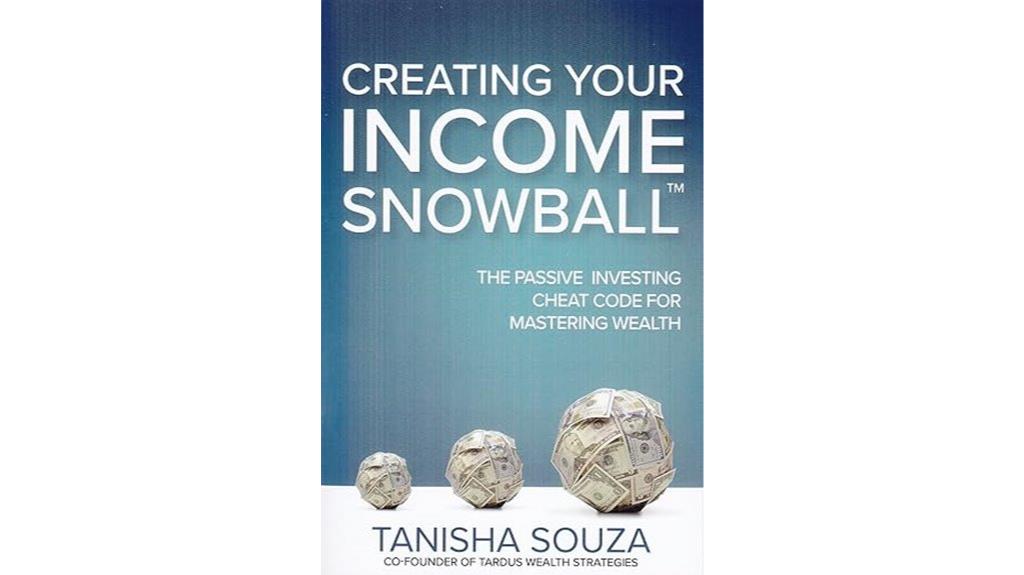
If you’re enthusiastic to open the secrets of building lasting wealth through passive income, then “Creating Your Income Snowball” offers a proven roadmap tailored for beginners aiming to master their financial future. This approach helps you generate hundreds or thousands of dollars monthly within just 45 days, often at up to a 90% discount on investments. You can build a portfolio of 10 rental properties in three years without personal savings and assemble a team of expert advisors to safeguard and grow your wealth. Using tools like the Income Snowball Calculator, you’ll learn how collective wisdom and strategic planning can accelerate your journey to financial independence.
Best For: Beginners and aspiring investors seeking a proven, data-driven roadmap to generate passive income quickly and build lasting wealth without prior experience.
Pros:
- Provides a clear, step-by-step strategy to achieve significant passive income within 45 days
- Utilizes innovative tools like the Income Snowball Calculator to predict and accelerate wealth-building timelines
- Includes real-life case studies and expert insights to guide investors through risk management and portfolio growth
Cons:
- May require an initial learning curve to fully understand and utilize the predictive tools effectively
- Investment opportunities at up to 90% discount may involve higher risk or require careful due diligence
- Building a diversified portfolio of rental properties and assembling a team of advisors can involve substantial time and effort
VOLUME PROFILE: The insiders guide to trading

Are you interested in understanding how institutional traders move the markets and how you can use that knowledge to improve your trading? *Volume Profile: The Insiders Guide to Trading* is an excellent resource for that. It teaches you to think and trade like “Smart Money” by revealing market manipulation and key levels through volume profile analysis. I found it invaluable for identifying liquidity zones, market makers’ footprints, and market structure. Dale’s clear strategies apply across intraday, swing, forex, and futures trading. The book emphasizes risk management, psychology, and practical insights, making complex concepts accessible for beginners and experienced traders alike.
Best For: traders seeking to understand market manipulation, improve their volume profile analysis, and implement institutional-inspired strategies across various markets and timeframes.
Pros:
- Provides clear, practical strategies applicable to intraday, swing, forex, and futures trading.
- Emphasizes risk management, psychology, and real-world application, making complex concepts accessible.
- Offers insights into market behavior, liquidity zones, and institutional footprints to enhance decision-making.
Cons:
- May require foundational knowledge of technical analysis and trading concepts for full comprehension.
- Some strategies and insights might need adaptation to individual trading styles or evolving markets.
- The book alone may not cover advanced or highly specialized trading techniques, necessitating supplementary learning.
Investing QuickStart Guide for Beginners

The “Investing QuickStart Guide for Beginners” stands out as the perfect starting point for anyone with zero prior investing experience who wants clear, practical guidance. Authored by industry veteran Ted D. Snow, CFP®, MBA, it offers over 100 pages of fresh content reflecting 2024’s market environment. With more than 100,000 copies sold worldwide, it’s trusted by over a million readers for its accessible advice. The book covers core strategies, asset classes, and modern trends like ESG investing and fintech. Plus, it includes free digital tools, empowering beginners to build confidence, diversify their portfolios, and start investing effectively right away.
Best For: Beginners with no prior investing experience seeking clear, practical guidance to start building wealth and understanding key investment concepts.
Pros:
- Accessible and easy-to-understand content tailored for newcomers
- Includes free digital tools to support investing education and decision-making
- Covers modern investing trends like ESG and fintech, keeping readers current
Cons:
- May lack advanced strategies for experienced investors
- Focuses primarily on foundational concepts, possibly oversimplifying complex topics
- Digital tools require internet access and basic tech familiarity
ETF Investing for Beginners: A Step-by-Step Guide

Starting your investment journey can feel overwhelming, but this step-by-step guide on ETF investing offers straightforward advice tailored for beginners. ETFs, or Exchange-Traded Funds, have become a favorite among investors worldwide because of their low costs, diversification, and ease of use. With over $9 trillion in assets, they cover everything from tech stocks to niche markets like renewable energy. This guide explains how to select the right ETFs, build a balanced portfolio, and even generate income with specific strategies. Whether you’re new or experienced, understanding ETFs can help you grow wealth, manage risks, and work toward your financial goals confidently.
Best For: Beginners and investors seeking a straightforward, low-cost way to diversify their portfolio and grow wealth over time.
Pros:
- Low fees and expense ratios making investing affordable for all.
- Broad diversification across sectors and asset classes reducing risk.
- Liquidity and ease of trading through stock exchanges, accessible for new investors.
Cons:
- Market volatility can still impact ETF prices, leading to potential losses.
- Certain leveraged ETFs carry increased risks and are unsuitable for all investors.
- Sector-specific ETFs may underperform if the targeted industry or trend declines.
How to Invest in the Stock Market Book for Beginners
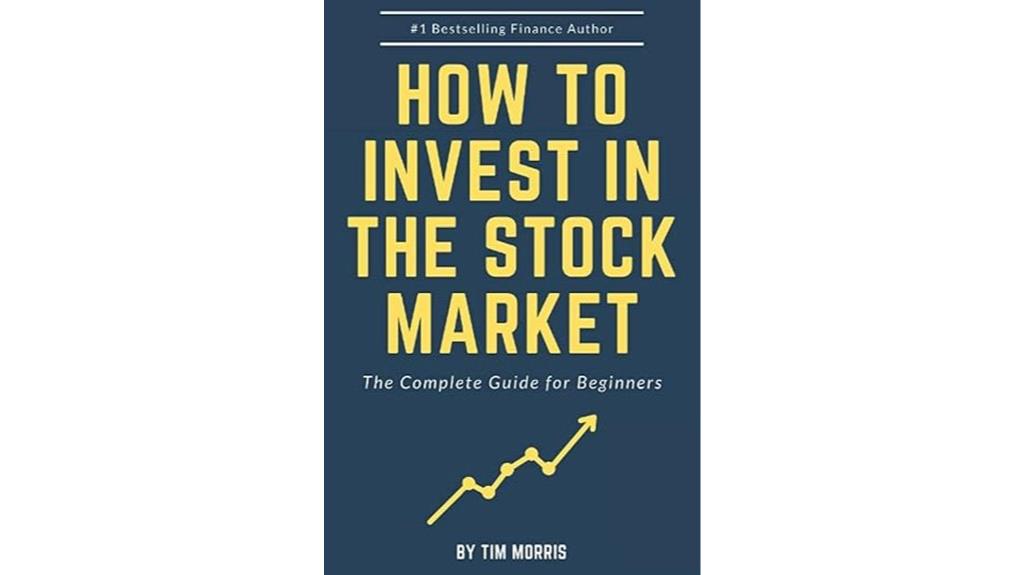
If you’re new to investing and want a clear, straightforward introduction to the stock market, Tim Morris’s “How to Invest in the Stock Market Book for Beginners” is an excellent choice. This concise guide covers essential concepts like stock history, key terminology, and investment strategies in an easy-to-understand way. It walks you through setting up brokerage accounts, analyzing stocks, and managing risks—everything a beginner needs to get started confidently. Many readers find it helpful for quickly grasping how markets work and making informed decisions. Its brevity and practical tips make it a perfect starting point for anyone enthusiastic to begin their investing journey.
Best For: Beginners seeking a clear, concise, and practical introduction to stock market investing to build confidence and start trading effectively.
Pros:
- Easy-to-understand explanations suitable for complete novices
- Covers essential topics like setting up accounts, analyzing stocks, and risk management
- Short, focused format makes it quick to read and absorb key concepts
Cons:
- May lack in-depth analysis for more advanced investing strategies
- Limited coverage of complex market topics or technical analysis tools
- Some readers might prefer more detailed case studies or real-world examples
Factors to Consider When Choosing an Investing for Beginners Book

When choosing an investing book for beginners, I look at how clearly it explains concepts and whether it offers practical strategies I can apply. I also consider if the content matches my experience level and if the author’s expertise seems credible. These factors help me find a book that’s both understandable and genuinely useful.
Clarity of Concepts
How can you tell if an investing book clearly explains key concepts? Look for books that use simple language, avoiding jargon that can confuse beginners. The best books break down complex topics like risk management or diversification into easy-to-follow steps, often using definitions, examples, and analogies to clarify abstract ideas like compounding. Well-structured content with a logical flow ensures you can follow from basic principles to more advanced strategies without feeling lost. Visual aids such as diagrams, charts, and summaries reinforce understanding and make important concepts stick. If a book combines clear explanations with these features, it’s likely to help you build a solid foundation—making your learning experience more accessible and less overwhelming.
Practical Strategies Offered
Choosing the right investing book for beginners means looking for clear, practical strategies that you can apply right away. I focus on books that break down essential steps like opening accounts, selecting investments, and managing risks in straightforward, actionable ways. Practical tools such as checklists, calculators, and detailed action plans are invaluable—they help me implement what I learn immediately. I also prioritize resources that emphasize long-term, disciplined investing, covering diversification, asset allocation, and cost minimization. The best books offer specific advice on investment vehicles like stocks, ETFs, bonds, and real estate, supported by real-world examples. Additionally, I look for books that highlight common pitfalls, behavioral tips, and risk management techniques to keep my investment journey steady and focused.
Target Audience Fit
Selecting the right investing book for beginners starts with making certain it’s tailored to your experience level and learning needs. Look for books that use clear, simple language and explanations suited for newcomers, avoiding unnecessary jargon. Consider whether the book is aimed at absolute beginners or those with some prior knowledge seeking structured guidance—this helps ensure the content matches your familiarity. Check if it addresses your specific goals, like building a solid foundation or gaining practical, actionable steps. The best books focus on fundamental concepts, making investing accessible and easy to grasp. Additionally, choose a book that motivates and empowers you through relatable examples and practical advice. Finding a good fit ensures you stay engaged and confident as you start your financial journey.
Depth of Content
When evaluating the depth of content in an investing book for beginners, it’s important to find a balance that provides enough detail to build a solid understanding without overwhelming you. A good book covers core principles like diversification and risk management while explaining more advanced topics such as asset allocation and investment strategies in accessible terms. It should include explanations of different asset classes, practical steps for starting to invest, and insights into market behavior, helping you make informed decisions. Be cautious of books that are too superficial—they might leave out crucial concepts like compound interest, expense ratios, or tax implications. Conversely, overly detailed books can be intimidating. The best choice offers enough depth to inform without causing confusion or information overload.
Author Expertise
Have you ever wondered how to gauge an author’s credibility before trusting their investing advice? It’s essential to look at their professional background and experience. Authors with finance degrees, certifications like CFP® or CFA, or advanced education often have a solid understanding of investment principles. Those who have managed real portfolios or held senior roles in financial firms tend to offer practical, experience-based insights. Additionally, check their track record—successful publications, notable achievements, or industry awards can signal expertise. Endorsements from financial professionals also add credibility. By considering these factors, you can better identify authors who provide trustworthy, well-informed guidance. Choosing books written by experienced, reputable authors ensures you’re learning from credible sources, setting a strong foundation for your investing journey.
Frequently Asked Questions
How Do I Choose the Best Investing Book for My Goals?
When choosing the best investing book for my goals, I start by understanding what I want to learn—whether it’s basics, strategies, or specific markets. I look for books tailored to my experience level and goals, read reviews, and check the author’s credibility. I also prefer books with clear examples and actionable advice, so I can easily apply what I learn to my personal financial journey.
Are Beginner Investing Books Suitable for All Age Groups?
Honestly, beginner investing books are like a magic wand—suitable for all age groups! Whether you’re a teen just starting out or a retiree seeking smarter money moves, these books break down complex ideas into simple steps. They’re designed to be accessible and adaptable, making investing less intimidating no matter your age. So yes, these books can truly be your lifelong financial allies—no matter where you are on your journey.
Do These Books Cover Both Stocks and Real Estate Investing?
Many beginner investing books do cover both stocks and real estate investing, but it varies. I’ve found some books focus mainly on stocks, while others explore real estate in depth. It’s important to check the book’s contents before diving in. I recommend selecting one that offers a balanced overview if you’re interested in both. That way, you get a solid start with the fundamentals of each investment type.
How Current Are the Investment Strategies Discussed in These Books?
Curiosity about current concepts keeps us keen, right? I’ve found that many investing books blend timeless tactics with recent trends, making strategies both solid and relevant. While some advice might feel slightly dated, core principles like diversification and dollar-cost averaging remain steadfast. I recommend checking publication dates and author updates to guarantee you’re absorbing strategies that are still fresh, functional, and fit for today’s financial landscape.
Can I Rely Solely on These Books Without Professional Advice?
You’re wondering if you can rely solely on these books without professional advice. I’d say, they’re a great starting point, but they shouldn’t be your only resource. Investing can be complex, and personalized guidance helps avoid mistakes. I recommend using these books as a foundation and consulting a financial advisor for tailored advice. That way, you build confidence while making smarter, well-informed investment decisions.
Conclusion
If you’re just starting out, these books can really set you on the right path. I still remember picking up my first investing book by chance at a local bookstore, and it changed everything for me. Sometimes, the right guide appears when you least expect it, guiding you toward smarter decisions. immerse yourself, stay curious, and trust that each page brings you closer to your financial goals—sometimes, luck and preparation go hand in hand.









